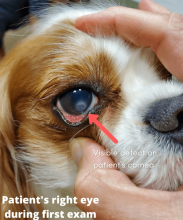By Dr. Heather Kovac
The Patient
Holly, a 5 year old female spayed Cavalier King Charles Spaniel, came to see me because she was squinting and rubbing at her right eye.
The Case
On physical examination, there was a mild amount of white discharge present at the inside corner of her right eye, she was squinting the eye moderately, and there was a visible defect on her cornea. I commonly see superficial injuries to the cornea in both dogs and cats. The cornea is the outside layer of the eye (where we would put a contact lens) and it is the most sensitive part of the body. The cornea should be completely transparent allowing visualization into the deeper parts of the eye. Dogs with larger and more exposed eyeballs (like Cavaliers, pugs, Shih Tzus, and bulldogs) are more likely to injure their eyes due to increased exposure and a shorter snout/nose to protect their eyes. Holly was obviously in pain and was trying to rub her eye. I recommended performing a test called a fluorescein dye test to allow me to determine just how deep the injury was. First, I numbed her eye with a topical anesthetic drop and then placed a drop of stain onto her cornea. If the top layer of the cornea is missing, the cornea will take up the dye, glowing a bright green, indicating an ulcer is present. Holly had a fairly deep corneal ulcer in her right eye from some unknown trauma. I also looked under all of her eyelids to make sure there was not a foreign body such as a foxtail or piece of grass stuck there causing the irritation. Nothing was found. Her left eye was normal.

The Treatment Plan
I prescribed a topical antibiotic ointment, oral pain medication, and dispensed an E-collar (aka cone of shame) to prevent her from rubbing at her eye. When pets rub at their eye, they can induce more damage and also delay healing of the cornea. The E-collar is a very important part of the treatment. I recommended a follow up in 1 week to assess healing.

The Outcome
One week later, I rechecked Holly and the visible corneal ulcer was resolved. I stained her eye again just to be sure since sometimes ulcers are not obvious with the naked eye. There was no stain uptake. Thankfully, Holly healed up quickly and was no longer in pain. All of the medications were stopped and she was free to remove the E-collar. Sometimes, corneal ulcers are more complex and require a higher level of care including debridement of the edges of the ulcer and even a contact lens to assist in healing. There is even a surgical procedure that rarely needs to be performed to allow the ulcer to heal.
If your dog or cat is squinting, or rubbing at the eye, or has an ocular discharge, please call to schedule an examination. Eyes are very delicate (and important!) and need prompt treatment when diseased.
The Drake Center for Veterinary Care is an AAHA-accredited animal hospital located in Encinitas, CA. The Drake Center loves being a source of information for all pet owners across the country however if you have any questions regarding pet care and do not live in Encinitas, CA or surrounding cities, we encourage you to contact your local veterinarian.
